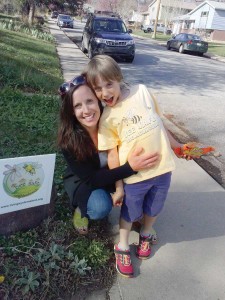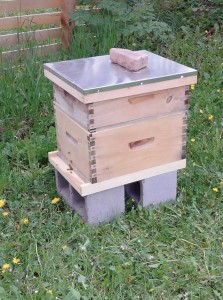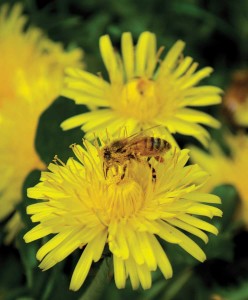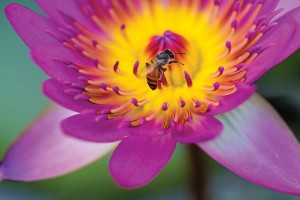The Buzz on Bees
28 Jun 2015
Is your yard bee-friendly or a bee bomb?
Here’s how to help these beneficial pollinators.
The world would be strangely quiet without the subtle hum of bees busily foraging the world’s 250,000 or so flowering plant species. Their prolific pollinating abilities have earned bees top billing as a keystone species. In North America alone, bees are responsible for billions of dollars each year in agricultural production, as well as sustaining wild plant communities. In other words, we need bees. Yet every summer we pull out an arsenal of chemicals to purge our lawns and gardens of unwanted insects like aphids and spider mites, and weeds like dandelions and field bindweed. In the process, our industrious bees take a hit. “Insecticides and pesticides directly impact invertebrates, including honeybees, butterflies and other pollinators,” says Mace Vaughan, pollinator program director for the Xerces Society (www.xerces.org), a nonprofit dedicated to preserving wildlife habitat for pollinators. “And these chemicals also affect native bees, which play a huge role in pollination.” On top of pesticide exposure, bees contend with habitat loss, a decrease in abundance and diversity of nectar sources, and harmful parasites. For bees, “it’d be like if we lived next to a chemical plant,” Vaughn explains, “eating the same thing every day and working in an overcrowded office where others might be sick and disease is spreading.”
 The number of Bee Safe Neighborhoods has grown in Boulder. The program has several pledge levels, ranging from avoiding chemical pesticides to installing a hive in your yard and planting organic, pollinator-friendly plants.
The number of Bee Safe Neighborhoods has grown in Boulder. The program has several pledge levels, ranging from avoiding chemical pesticides to installing a hive in your yard and planting organic, pollinator-friendly plants.Nix Neonics
Greacen became alarmed about the decline in bee populations after reading Poison Spring: The Secret History of Pollution and the EPA by E.G. Vallianatos, a former EPA employee within the pesticide division. “Chemical companies use their own laboratories to test products,” Greacen says, “allowing them to push their products into the market as quickly as possible.” Once pesticides are approved and registered, it’s virtually impossible to unregister them without massive, unequivocal evidence of harm. The book also describes the routine suppression of data linking pesticides to soaring cancer rates, birth defects and chronic disease. “Roundup, for example, is extremely toxic. Yet it’s widely sold in stores,” Greacen says. “The concentration of Roundup in our food, water and bodies is linked to high rates of autism in children. And it just came out that it’s cancer causing.” Within this toxic soup of Roundup and other pesticides sold in stores is a class of insecticides called neonicotinoids, which are also commonly used in the plant nursery industry and big agriculture. Seeds and plants sold in most stores and used by landscaping and tree companies are coated and infused with these chemicals, which systemically affect the plant’s roots, stems, leaves, pollen and nectar.
Neonicotinoids are also common in treatments for turf grass, trees, shrubs and flowers. The soil around treated plants becomes affected. Depending on the plant and neonicotinoid product, it can persist in the soil for months, and even years.
Once praised for their low risk to bees and other beneficial insects and their toxicity to insect pests, neonicotinoids act on receptors in the nerve synapse. It’s recently been discovered that bees become addicted to plants treated with these types of chemicals. They collect pollen and take it back to their colony, where exposed bees soon demonstrate poor navigation and foraging capabilities. The colony then declines in growth and nest condition. In native bumblebee colonies, the number of workers and immature bees drops significantly, along with the amount of honey.
“Bayer, Safari, Syngenta, Ortho—all these companies and others make tons of different products with these neonics in them,” Greacen says, “everything from pesticide sprays to fertilizers for turf and amendments for soil.”
Neonicotinoids also kill earthworms and other beneficial soil organisms, as well as some butterfly caterpillars. “We need these beneficial insects,” Greacen says. “We can’t just go killing them all, because what harms these animals also harms us.” (Europe banned the use of three neonicotinoids in 2013.)
The more she and her neighbors learned about the pesticide industry, the more urgent their mission became. “Very early on, as we were gathering information, we learned that all of the non-organic plants for sale all over the country and in all of our stores have been pretreated with neonic pesticides.” It was then that they realized the need for sources where people could buy neonicotinoid-free products. They also wanted to teach other communities how to make positive change. And they wanted the city of Boulder to adopt Bee Safe policies.
Within this toxic soup of Roundup and other pesticides sold in stores is a class of insecticides called neonicotinoids, which are also commonly used in the plant nursery industry and big agriculture. Seeds and plants sold in most stores and used by landscaping and tree companies are coated and infused with these chemicals, which systemically affect the plant’s roots, stems, leaves, pollen and nectar.
Neonicotinoids are also common in treatments for turf grass, trees, shrubs and flowers. The soil around treated plants becomes affected. Depending on the plant and neonicotinoid product, it can persist in the soil for months, and even years.
Once praised for their low risk to bees and other beneficial insects and their toxicity to insect pests, neonicotinoids act on receptors in the nerve synapse. It’s recently been discovered that bees become addicted to plants treated with these types of chemicals. They collect pollen and take it back to their colony, where exposed bees soon demonstrate poor navigation and foraging capabilities. The colony then declines in growth and nest condition. In native bumblebee colonies, the number of workers and immature bees drops significantly, along with the amount of honey.
“Bayer, Safari, Syngenta, Ortho—all these companies and others make tons of different products with these neonics in them,” Greacen says, “everything from pesticide sprays to fertilizers for turf and amendments for soil.”
Neonicotinoids also kill earthworms and other beneficial soil organisms, as well as some butterfly caterpillars. “We need these beneficial insects,” Greacen says. “We can’t just go killing them all, because what harms these animals also harms us.” (Europe banned the use of three neonicotinoids in 2013.)
The more she and her neighbors learned about the pesticide industry, the more urgent their mission became. “Very early on, as we were gathering information, we learned that all of the non-organic plants for sale all over the country and in all of our stores have been pretreated with neonic pesticides.” It was then that they realized the need for sources where people could buy neonicotinoid-free products. They also wanted to teach other communities how to make positive change. And they wanted the city of Boulder to adopt Bee Safe policies.
Naturally Healthy
Boulder now has six official Bee Safe communities and neighborhoods, and about 25 neighborhoods are in the process of signing up, including ones in Wheat Ridge, Washington Park and as far away as Virginia. Thirty-three Boulder County businesses have also signed on, agreeing to sell only neonicotinoid-free plants and offer education about bee-friendly gardening and organic pest-control options. In January, Bee Safe Boulder brought a resolution to the city council for a ban of neonicotinoids on city-owned property. On May 5, the city adopted the resolution. Boulder’s Urban Farm Co. of Colorado signed the Bee Safe Boulder pledge. Since 2011, the company’s designed somewhere around 700 organic gardens for homeowners, and helped existing gardeners amend their soil to grow their own food. Of the 97 different crop plants Urban Farm Co. sells, 100 percent are neonicotinoid free. Pest and disease problems are typically caused by chemically unbalanced soil, says Urban Farm Co. owner Bryant Mason. Or your plants could be growing in the wrong location of the yard where they’re getting too much or not enough sun. “Pests are Nature’s garbage collectors and diseases are her cleanup crew,” he says. But healthy plants have a natural immunity to pests and disease. If you’re having problems, test your soil to find out if amendments are needed. “For example, aphids are oftentimes a problem if there’s too much nitrogen in the soil,” Mason says. Using organic mulch around plants to keep the soil consistently moist through the season also deters invaders. “That decreases plant stress and increases a plant’s functional immunity, allowing it to fight off pests and disease.” You should also plant for diversity rather than in monocultures, such as expansive lawns, which promote pests and disease. “And if you do get pests, do things naturally, like plucking off cabbage worms with your hands and spraying aphids with soapy water.” The Bee Safe project is pushing people to ask questions, Mason says. “Basically, the mind-set is shifting to how we can increase the strength and health of our plants and not to how do we spray chemicals until nothing is left except our plant?” For Greacen, the project’s success has been encouraging. “Everyone I talk to here knows about Bee Safe and they’re excited about it,” she says. “When you organically garden, you feel like your kids and pets are safe out in the yard. And you feel safe walking and playing in the grass. And you’re helping out bees, too.”10 BEE TIDBITS
- Of the 20,000 or so bee species in the world, approximately 4,000 are native to North America. Honeybees were actually brought to North America by European colonists in the 17th century to help pollinate crops.
- Colorado has nearly 950 native bee species, and 555 of those have been identified in Boulder County alone. Some are large and hairy, like bumblebees. Others are tiny and hairless.
- Most bee species need to feed from a variety of blossoming plants for optimum health. Others, like squash and sunflower bees, are specialists who only feed on certain plants.
- Male bees cannot sting because they don’t have stingers.

- About 70 percent of native bees in North America are solitary ground nesters who dig into bare or sparsely vegetated soil. Their nests are nothing more than small holes surrounded by little mounds of dirt.
- Bees have relatively small flight ranges (a mile or two for bumblebees and only a couple hundred yards for some of the smaller species), so it’s important to have enough diverse forage in close proximity.
- Leafcutter bees carve out small circles in leaves and petals, which they cobble together into bunting-like protection for their larvae. They nest in rock crevices, beetle tunnels, hollow plant stems and man-made bee nests.
- Polyester bees didn’t get their name from wearing polyester. They actually secrete a cellophane-like substance to line their waterproof brood cells, allowing them to nest in flooding areas such as stream banks.
- Cuckoo bees are parasitic and lay their eggs in the nests of other species. When their larvae emerge, they kill the host bee’s eggs or larvae.
- Squash bees nest in the ground at the base of squash plants, including pumpkins, watermelons, squashes and gourds. Females dig into the ground and males spend the night sleeping inside the closed flowers.
By Ruthanne Johnson












